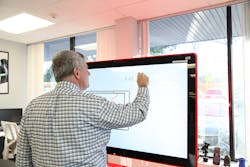Do You (Really) Want Bleeding-Edge Technology?
It’s popular to say that your company wants to implement the latest “bleeding-edge” technology. But I suggest that you think twice before really trying to live with bleeding-edge technology. It’s important to recognize the benefits and pitfalls in building your business around the newest technology elements in your product. This article describes the implications as well as a bit of strategy for life on the forefront of the latest technology.
Examples of Bleeding-Edge Technology
Though not exhaustive, here are a few of the categories where bleeding-edge technology may be tempting for your new product development:
- Displays: The world of displays has been a place for bleeding-edge development over the last few decades. Among the latest technologies currently generating excitement are curved displays, bendable displays, and ever-increasing resolutions, brightness, and refresh rates.
- Cameras: Cameras are continuing to evolve at a rapid pace with the bleeding edge, including cameras with higher resolutions, low-ambient-light capabilities, and faster frame rates.
- Batteries: Chemistries continue to evolve along with flexible batteries and batteries in unusual form factors.
- Microprocessors: For more than 30 years, microprocessors have continued to evolve with faster processing speeds, smaller footprints, and lower power demands along with ever-higher levels of functions integrated into the chip level.
- RF communications: Discrete radios in the cellular, Wi-Fi, and low-range/low-energy domains continue to evolve very rapidly. Radio chipsets and modules are integrating multiple RF technologies. Fast-emerging technologies in the 5G and Wi-Fi 6 spaces are among the hottest topics along with conflicting and confusing options at the low end.
The Hyper-Spectral Camera, designed by Intelligent Product Solutions, is a multi-sensor, multi-spectral imaging device that reads the presence of each unique DNA/Fluorophore marker.
Of course, these aren’t the only domains on the cutting edge. But, for those of us in the tech space, any product development plans are likely evaluating these categories in the planning process.
The Benefits
There are certainly clear benefits to implementing the latest technologies. Among them may be:
- The ability to introduce new product features ahead of competitors.
- Opportunities to promote competitive advantage in your marketing campaigns.
- Potential chances to offer novel and valuable usability and performance gains.
- Sustainment of product leadership positions.
Groundbreaking new products, and even incremental updated product variants, often are based on elements of bleeding-edge technology. From time to time, one will see this in cell phones, for example, where a leapfrog capability in a technology can be used to create an advantage.
With mixed results, Samsung did this with the introduction of the foldable cellphone display. While the initial product release versions had issues with the technology, the use of this cutting-edge tech helps Samsung establish an innovation leadership position. Well-executed, leading-edge technology can help with this leadership position and also create a “greenspace” for a novel new product to grab market share with early adopters.
The Pitfalls
Along with the potential benefits, companies need to consider the potential drawbacks to using bleeding-edge technology. The risks include:
- Immature technology is more prone to reliability problems.
- Bleeding-edge technology may result in supply-chain problems as manufacturers run into volume production issues when trying to scale.
- Costs may be high for components or subassemblies using technology at the cutting edge.
- Besides supplier ramp-up issues, the supply of bleeding-edge technology may be totally sucked up by one or two large players “buying up” manufacturing capacity.
- The aforementioned issues can result in delays in integrating new technology, iterative design trying to keep up with changes from early stage technology, and supply shortages that push out product builds and delivery.
Given these potentials for field-failure, supply-chain, schedule, and cost impacts, one should approach bleeding-edge technology with eyes wide open. In addition, it should be implemented with an acceptance of inherent risk and the fact that there’s a much higher likelihood of failure or negative impacts to product development when incorporating brand new technologies.
Strategies for Bleeding Edge
The author working on a Google Jamboard, a cloud-based collaborative digital whiteboard.
Ok, so after considering the risk/rewards, if you’re committed to implementing bleeding-edge technology, here are some techniques for controlling the risk and limiting the exposure:
- Opt for one step back from the absolute bleeding edge where the costs may be optimized, the initial tech bugs have been resolved, and the supply sourcing is in a more predictable and available state.
- Rather than implement numerous bleeding-edge technologies at once, grab onto just one or two of the highest value pieces.
- Build the risks into your project schedule. Allow for more iterative design—the need for which will undoubtedly arise as the technology evolves in parallel with your development.
- Include more extensive design and manufacturing verification testing into your process. Implement a higher level of stress testing and, in certain cases, consider implementing High Accelerated Life Testing (HALT) at the component or subassembly levels.
- Validate the value of the bleeding-edge technology to your potential client base. There’s limited use in absorbing risk for a technology-based cutting-edge capability that your customers don’t value (or aren’t willing to pay for).
- Assess the risk of increased field reliability issues to ensure there’s a plan for dealing with early delivered product failures.
Bleeding-edge technology certainly has its place and can provide significant advantages to your product strategy and roadmap. In making decisions related to bleeding edge, make sure you’re staying cognizant of the risks and pitfalls. When possible, try to ensure your early customers are well aware of all inherent risks and benefits so that they can join you in making informed decisions and assessments. Implement tactics to help ensure that the implementation of the technology is properly managed and that the risks can be appropriately mitigated.
Mitch Maiman is President of Intelligent Product Solutions (IPS).



